|
|
|
Sort Order |
|
|
|
Items / Page
|
|
|
|
|
|
|
| Srl | Item |
| 1 |
ID:
188744
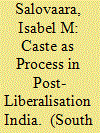

|
|
|
|
|
| Summary/Abstract |
The task of recent scholarship on India’s post-liberalisation period has been, in part, a re-casteing: a deliberate investigation of the ways in which historically embedded hierarchical divisions are continually reworked and thereby reinvigorated. Amid contemporary debates over the forms, sites and effects of caste and caste discrimination, this article identifies a shift in critical scholarship towards understandings of caste as process. Processual readings of caste within market- and merit-based institutions productively reframe caste in India from a ‘relic’ undergoing erosion to an accretion of new layers and logics upon older principles of innate human value.
|
|
|
|
|
|
|
|
|
|
|
|
|
|
|
|
| 2 |
ID:
188751
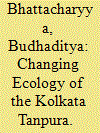

|
|
|
|
|
| Summary/Abstract |
The tanpura, a long-necked, unfretted, stringed lute, is arguably one of the most important instruments used by Hindustani classical vocalists. This ethnographic study draws from the lived experiences of luthiers and farmers specialising in crafting tanpuras. Auto-ethnographic reflections as a vocalist of this tradition also feed into this piece. Studying the effects of various phenomena, including evolving agricultural and climatic conditions in gourd fields and increasing scarcity of raw materials, the article underlines how it affects the sonic and visual profile of the instrument, thereby gradually transforming Hindustani classical sound at a very fundamental level.
|
|
|
|
|
|
|
|
|
|
|
|
|
|
|
|
| 3 |
ID:
188752
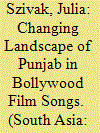

|
|
|
|
|
| Summary/Abstract |
Music has played an integral part in defining the sense of self for Punjabis at home as well as in the national and transnational diasporas. The images of the homeland have played a significant role in shaping the imagery of Punjabi music, therefore it is self-explanatory that Bollywood music has also incorporated a vast number of references to Punjabi localities when representing Punjab on screen. This paper investigates the representation of Punjab in Bollywood music through a textual analysis of a variety of Bollywood songs that discuss the imaginary and real landscapes of Punjab. I suggest that the image of Punjab has played an important role in post-liberalisation popular culture in India—however, the exact nature of this image has undergone significant change. Traditionally, the representation of Punjabi culture was tied to poetic and visual images of the landscape of Punjab and was used to evoke nostalgia and a bucolic idyll. However, recently, Punjabi culture has been dislocated from the land itself and represented as part of a global culture of aspiration and consumerism.
|
|
|
|
|
|
|
|
|
|
|
|
|
|
|
|
| 4 |
ID:
188753


|
|
|
|
|
| Summary/Abstract |
Coastal landscapes inspire their own genre of folk songs and musical instruments intrinsic to the traditions of the local boat people and fisherfolk, often coexisting with a strand of popular music embedded within the modalities of coastal tourism. In post-colonial coastal cities, these strands are part of a larger musical space carved out by the legacies of colonial cultural transmission and subsequent assimilation into aspirational European cosmopolitan tropes. I examine the shifting engagement of Western classical choirs in the context of two coastal cities: Goa in India and Colombo (with a focus on Negombo) in Sri Lanka. Combining in-depth interviews with two choral conductors alongside the predicament of musical production in the digital space, I argue that choral music impinges on a notion of personal intimacy that combines a collective sense of creativity and community, organically linked to Catholic landscapes animated by a ‘Catholic affect’.
|
|
|
|
|
|
|
|
|
|
|
|
|
|
|
|
| 5 |
ID:
188745


|
|
|
|
|
| Summary/Abstract |
This essay offers an introduction to a special section on ecology and performance in South Asia. Aiming at ‘green’ studies of music and performance, this collection explores intersections between ethnography, history, eco- and ethnomusicology, and film and performance studies by paying particular attention to the ecological turn more broadly visible in South Asian studies. The papers address varied ecological settings of South Asian music and performance, from riverscapes to coastal communities, and from the locations of instrument-makers to negotiations of the climate crisis and the COVID-19 pandemic. The novelty of the section lies not just in mapping the dialogism between ecology and music through reflections on liminality, gender, resistance and identity, but also in bringing forth new archival strategies (digitisation and digital cultures) in conversation with ethnographic findings.
|
|
|
|
|
|
|
|
|
|
|
|
|
|
|
|
| 6 |
ID:
188748


|
|
|
|
|
| Summary/Abstract |
This study examines the flood songs of Malabar written as performative literary texts in the Arabi-Malayalam language that were prevalent among the Muslim community of Malabar in the twentieth century. These songs were written as eyewitness accounts of the historical monsoon floods that afflicted the coastal regions and hinterlands of Malabar on the shores of the western Indian Ocean. Flood songs as a genre offer a combined understanding of ecology, religion and performance of the recurrent floods that occurred in twentieth-century Malabar. They also provide details about the importance of collective memorialisation and the commemoration strategies adopted to record the seasonal disastrous floods which still afflict the region. This paper puts forth two fundamental questions regarding flood songs: first, how did flood songs ideologically define and internalise the origins and causes of environmental disasters in an oceanic-riverine complex? Second, how did these songs aesthetically express the religious experience of the flood, adaptations to them, and ways of managing the risks they imposed? This study investigates the unique manifestations of spirituality, music/sound and nature and the environment in the flood songs of Malabar, topics which remain unexplored in academic literature.
|
|
|
|
|
|
|
|
|
|
|
|
|
|
|
|
| 7 |
ID:
188746
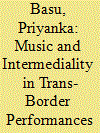

|
|
|
|
|
| Summary/Abstract |
Climate crisis has emerged as an important theme in the performances of patachitra or scroll painting in West Bengal. Besides depicting contemporary subjects, the scrolls also tell traditional stories, such as that of the Manasamangal, through songs and visuals. Across the border, in Bangladesh, the Manasamangal narrative finds numerous embodiments in living traditions, thus closely highlighting a human–nature connection. This paper considers several such performance genres and studies them through the intermediality of printed literature, visual depictions, sound recordings and performance practices in curated spaces. In doing so, it challenges the land-centric frameworks of disciplines and instead understands them through a liquescent methodological approach.
|
|
|
|
|
|
|
|
|
|
|
|
|
|
|
|
| 8 |
ID:
188747
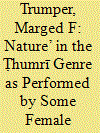

|
|
|
|
|
| Summary/Abstract |
I discuss the treatment of the theme of nature in ṭhumrī by some female exponents of the Pūrab Aṅg (eastern style) in the various contexts where these artists were and are active, especially in the phase of transition from the style of hereditary performers to a new middle-class style of ṭhumrī. I elaborate on how courtesans have turned the rendition of these themes into one of their tools of covert resistance, given their default liminality and their marginalisation in the early twentieth century, and have later passed on this strategy to some non-hereditary women, who have adapted it to the bourgeois urban context maintaining its liminal features.
|
|
|
|
|
|
|
|
|
|
|
|
|
|
|
|
| 9 |
ID:
188749


|
|
|
|
|
| Summary/Abstract |
Conceived as a life force, rain has a significant place in Indian thought. Sanskrit and vernacular literary and religious texts, as well as visual arts, emphasise its auspiciousness and importance in human life. Additionally, through the use of poetical images and metaphors, these texts and images associate rain with music and identify thunder with drums. Through the analysis of compositions from the repertoire of different drums such as the dhrupad pakhāvaj, the miḻāvu of Kūtiyāṭṭaṃ Sanskrit theatre, and the ritual music of Brahmanical temples of Kerala, this article studies the association of drumming with rain as a symbol of life force, consciousness and enlightenment.
|
|
|
|
|
|
|
|
|
|
|
|
|
|
|
|
| 10 |
ID:
188743
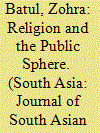

|
|
|
|
|
| Summary/Abstract |
The engagement of religion in political movements adds credibility to the struggle and commands participation that is difficult for believers to disregard. The political leaders in the Kashmir Valley, from a range of positions, have gained legitimacy by linking their political movements to Islam and its icons, such as shrines and mosques, particularly in the early twentieth century. Owing to the enduring conflict in Kashmir and limited spatial availability for dissent, sacred spaces have emerged as the predominant sites of political mobilisation. By employing ethnographic research and critical discourse analysis, this study demonstrates that mosques and shrines play a notable role in Kashmir’s politics, facilitating the articulation of an oppositional discourse to the statist narrative. The article further states that the use of sacred sites and other religious symbols has favoured an Islamic framework in the conflict politics of Kashmir; nevertheless, it is not essentially an Islamic movement in terms of its goals and convictions. These concerns are explored in congruence with the ways in which religious nationalisms intersect with political movements in the public sphere of non-Western societies.
|
|
|
|
|
|
|
|
|
|
|
|
|
|
|
|
| 11 |
ID:
188750
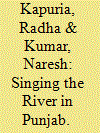

|
|
|
|
|
| Summary/Abstract |
This paper traces the centrality of rivers in twentieth-century and contemporary popular music and poetry in the regional context of Punjab in the north-west of the subcontinent. In contrast to the riverine imaginations in the songs of eastern or central India, we look at the very different evocations of rivers—both real and conceptual—in the subcontinent’s north-west. Rivers feature centrally in the love legends, devotional and folk poetry, and songs of Punjab, and here we trace a river-based ‘hydropoetics’ in Punjab, querying land-focused perspectives. From the metaphysical and the sacred to the sensual, and from the realms of the quotidian to those of mourning and trauma, we argue that in Punjab, ‘singing the river’ is central to people’s definitions of regional and ontological identity, and to the way they understand their place in the world.
|
|
|
|
|
|
|
|
|
|
|
|
|
|
|
|
|
|
|
|
|